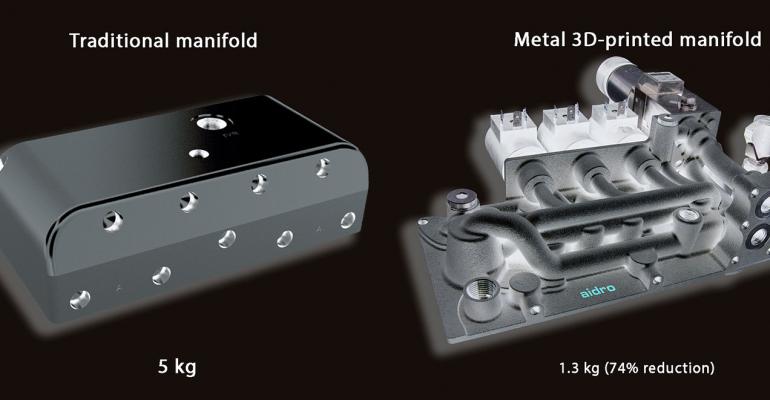 One example of how 3D printing has advanced is in the 3D printing of hydraulic components. Until recently, 3D printed parts were not strong enough to manage the high pressures that hydraulics require, but that’s changing. Hydraulics involve optimizing the flow of air or liquid to obtain high power from a small, lightweight package. An example of a particularly important hydraulics application is the “jaws of life,” which are used to extract people from the wreckage of accidents. These tools need to be small and lightweight enough to be carried easily and fit into small spaces, but they also need to be able to produce tons of force.
One example of how 3D printing has advanced is in the 3D printing of hydraulic components. Until recently, 3D printed parts were not strong enough to manage the high pressures that hydraulics require, but that’s changing. Hydraulics involve optimizing the flow of air or liquid to obtain high power from a small, lightweight package. An example of a particularly important hydraulics application is the “jaws of life,” which are used to extract people from the wreckage of accidents. These tools need to be small and lightweight enough to be carried easily and fit into small spaces, but they also need to be able to produce tons of force.
Italian company Aidro manufactures hydraulic systems, and since last year has been using metal 3D printing in its manufacturing processes. Designers for the company wanted to make a portable hydraulic power unit (HPU) as lightweight as possible, and tried as many tactics as they could think of to reduce weight and size. Integrated hydraulic circuits using cartridge valves were used instead of line-mounted valves, the minimum number of components were used, and the fluid lines were made as short as possible. Then they realized that they could reduce the weight even further with additive manufacturing.
Typically, HPU manifolds are machined from a solid block of metal. Often, removing more excess metal than absolutely necessary is expensive, so that excess metal is left, resulting in a part that weighs more than it has to. With additive manufacturing, material is added from nothing, so only the necessary components are created – there’s no excess baggage, so to speak. Machining is also limited to producing certain configurations, like oval or squared-off fluid channels that can carry the same flow as a round channel, but in less space.
 In conventionally machined manifolds, passageways typically must be positioned to prevent cross-drilled channels from intersecting and to allow enough material between channels to provide enough strength. Auxiliary holes drilled to connect internal passageways usually need to be plugged to prevent cross-channel flow. 3D printing allows for more complex channel design, which in turn allows for greater flow within a smaller space. Hole plugs are not necessary, either, as the passageways connecting the internal channels don’t have to be machined from outside the manifold.
In conventionally machined manifolds, passageways typically must be positioned to prevent cross-drilled channels from intersecting and to allow enough material between channels to provide enough strength. Auxiliary holes drilled to connect internal passageways usually need to be plugged to prevent cross-channel flow. 3D printing allows for more complex channel design, which in turn allows for greater flow within a smaller space. Hole plugs are not necessary, either, as the passageways connecting the internal channels don’t have to be machined from outside the manifold.
The two 3D printing technologies typically used for hydraulics manufacturing are direct metal laser sintering (DMLS) and selective laser melting (SLM). DMLS heats the metal powder until the particles fuse together, allowing the porosity of the part to be controlled. It can also be used with a variety of alloys, so functional prototypes can be made out of the same material as the final components. SLM uses a laser to melt powder into a finished part, which results in reduced porosity and a high-strength part.
Aidro used 3D printing to create an HPU manifold that weighs about a quarter of a manifold machined from a solid block of metal. Sold on the technology, Aidro began offering 3D printing as a service. In addition to weight reduction, Aidro’s 3D printed manifolds have strong material properties, high-pressure resistance and optimized performance thanks to curved channels rather than 90-degree intersections. The company also offers 3D printed heat exchangers, with the potential to combine multiple parts into one, and hydraulic valve blocks.
One application where 3D printing is sure to play a role is in advanced hydraulics. In hydraulic systems where weight and size is important 3D printing is also going to naturally play a role. We think we’re going to be seeing a lot more applications such as this one in the future.
Discuss this and other 3D printing topics at 3DPrintBoard.com or share your thoughts below.
[Source: Hydraulics & Pneumatics]
Subscribe to Our Email Newsletter
Stay up-to-date on all the latest news from the 3D printing industry and receive information and offers from third party vendors.
You May Also Like
3D Printed Heat Spreader Could Improve Efficiency of Electronics
The low-hanging fruit for decarbonization has long been improving the efficiency of existing systems, hence the justification for LED lights and ENERGY STAR certified appliances. While such minor moves are...
3D Printing News Unpeeled: Marine Gearboxes, 3D Printed Motors and $1.7 Million in Seed Funding
UK based Equipmake just released their Ampere-220 e-axle system. The system, which is meant for high performance electric cars, was similar to one released on the Ariel HIPERCAR. It has...
CEAD Unveils 36-Meter-Long 3D Printer for Abu Dhabi’s Al Seer Marine
CEAD, a Dutch original equipment manufacturer dedicated to large-format 3D printers, has unveiled what it claims to be the world’s largest robotic arm-based 3D printer. At 36 meters long and...
3D Printed Biocomposites Could Help Reduce Marine Plastic Pollution
Concerns about the impact of plastic litter and microplastics in the oceans are at the forefront of environmental study. For decades, the marine environment has suffered from the degradation of...





































